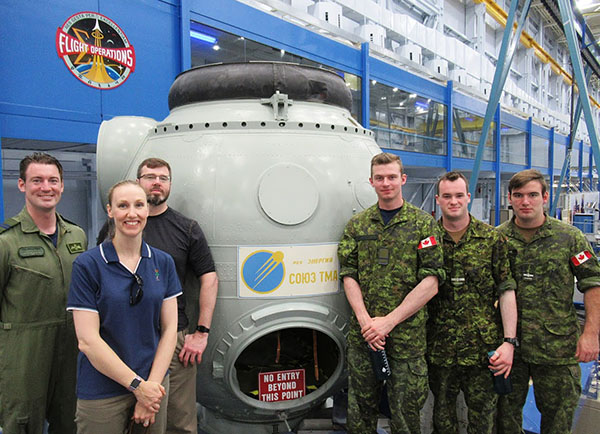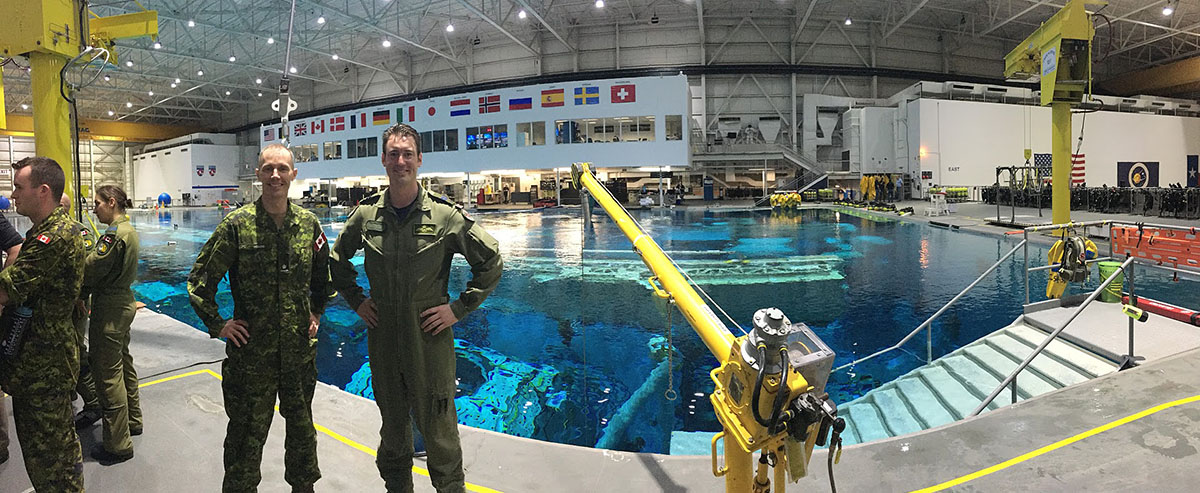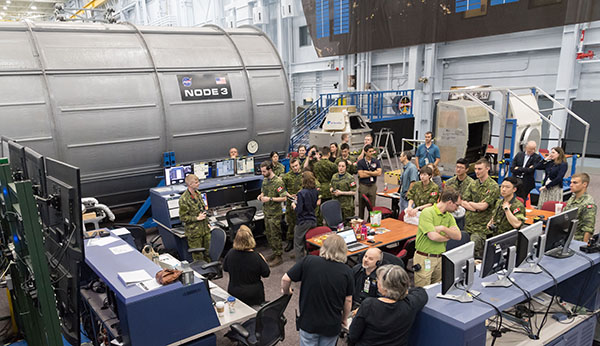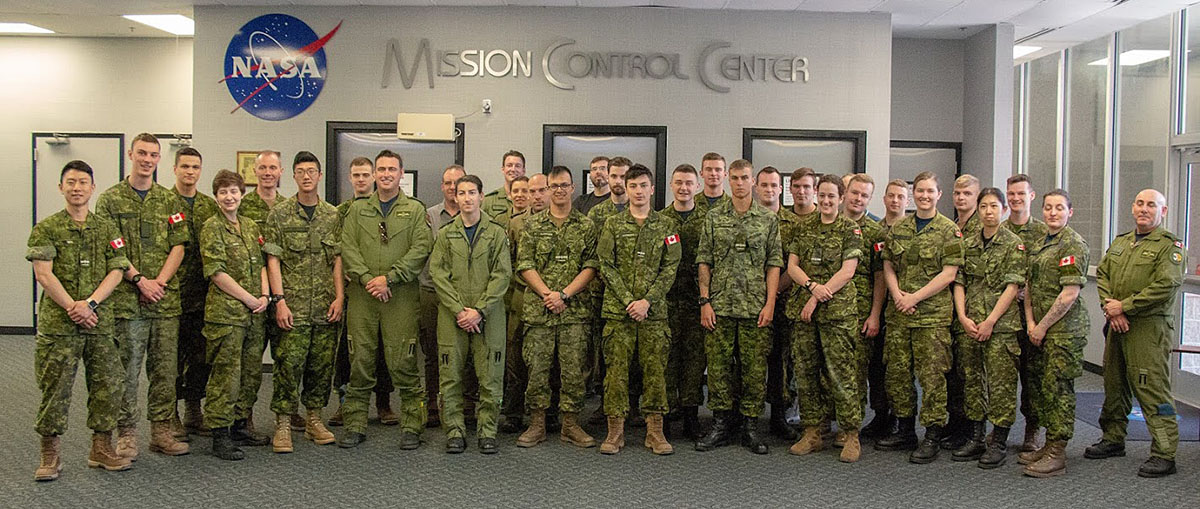 Capt. Dan Desjardins, Dr Kristine Spekkens and Dr Gregg Wade (left) and officer-cadets (right) in front of a Soyuz capsule
Capt. Dan Desjardins, Dr Kristine Spekkens and Dr Gregg Wade (left) and officer-cadets (right) in front of a Soyuz capsuleWhere Canadian Astronauts are Made
Royal Military College Physics and Space Science officer cadets visit Johnson Space Center
By Capt Daniel Desjardins
11 May 2018
On the morning of 8 May, a group of twenty-two intrepid RMC officer cadets and five staff members boarded a CC130H Hercules, compliments of 424 Transport & Rescue Squadron, to fly to Houston, TX for a memorable visit of NASA’s Johnson Space Center (JSC). The trip was an initiative by the Department of Physics and Space Science to educate their students on human spaceflight and space operations, effectively bridging concepts learned in the classroom to real operational environments.
The skies were clear for the departure out of Trenton. “The weather couldn’t be any better,” said Capt Dagneault, the CC130H aircraft commander in charge of transporting the RMC crew to Houston. The flight was smooth and appeared effortless, taking only slightly over four hours to reach destination. While airborne, officer cadets and RMC staff were invited to listen in on aircraft communications, visit the cockpit, and witness the professional aircrew at work.
After completing check-in and luggage drop-off, the students and staff, joined by the CC130H aircrew, regrouped at T-Bone Tom’s restaurant near the Kemah boardwalk for some exquisite Texas smokehouse BBQ and live music by a local Houston artist. The highlight of the evening, however, was being joined by LCol Josh Kutrick, selected as a Canadian astronaut in 2017. “What an amazing opportunity for everyone, to have dinner and chat with Josh” said Dr. Gregg Wade, Department Head of Physics and Space Science.
 Major Don Bedard and Capt Dan Desjardins standing in front of the NBL pool
Major Don Bedard and Capt Dan Desjardins standing in front of the NBL poolThe following morning, after a hearty breakfast and check-out complete, the group boarded the bus for the much-anticipated tour of JSC. First up was a visit of the Neutral Buoyancy Lab. Try to imagine a gigantic swimming pool, 102’ x 202’ in size and 40’ deep, containing over six million gallons of water and filled with space station modules and capsule mockups. “The astronauts train underwater for up to six hours, sometimes more, simulating extravehicular activities” said Tim Braithwaite, Canadian Space Agency Liaison Office Manager, who had joined the group for the tour.
The group was welcomed via teleconference by Canadian astronaut Col Jeremy Hansen, himself an RMC graduate. After watching astronauts suit-up and be hoisted into the pool for extravehicular activity (“spacewalk”) training, the group proceeded on a tour of the International Space Station Mission Control Center. It was surreal, like a scene from the movies. Screens and buttons were everywhere, and flight controllers gracefully coordinating every single instruction beamed to the International Space Station. It was an elegant display of command and control, the gold standard of professionalism for which NASA is known.
 Guided tour of Building 9, home to the Space Vehicle Mockup Facility
Guided tour of Building 9, home to the Space Vehicle Mockup FacilityNext on the tour was a floor-level visit of Building 9, home to the Space Vehicle Mockup Facility. Floor-level visits there are rare: this was an ultra-VIP experience. Up close, the RMC group got to see full-size Space Station modules, exploration rover prototypes, the Orion and Soyuz space vehicles, and even R5, NASA’s next generation of humanoid robot. Since 1980, every NASA astronaut has walked the floors of Building 9; it was truly inspiring to visit.
The tour concluded with lunch at the Starport Cafe in the JSC complex - and no, there was no freeze-dried ice-cream on the menu. There, we were joined by Dr. Jenni Sidey, the second Canadian astronaut selected in the Canadian Space Agency’s 2017 recruitment. Despite a busy schedule of training and tests, she took great interest in meeting and conversing with our eager group of RMC officer cadets. We were also joined by Ms. Kathleen Garrett, the key person to whom we owe the successful planning of this tour. Thank you very much Cathy.
In closing, academic tours such as these are invaluable. In the first order, future officers are exposed to elite training environments and to role models striving for excellence in everything that they do. At JSC, the inspiration to go further, be better, and work harder was almost palpable; it is a message that resonates well with the College’s four-pillar philosophy. In the second order, the officer cadets were exposed to Canadian Air Force operations aboard the C130H. The professional aircrew invited students and staff to cycle through the cockpit while en route to Houston, answering questions and asking the students about their future careers. RMC civilian staff also partook in the events and got to see first-hand the operational environments in which their students would eventually serve. In sum, the trip was much more than a visit to the JSC, it brought together RMC officer cadets, civilian and military faculty, and a serving CAF aircrew. Few training opportunities are as rich and impactful, and it is hoped that RMC will continue to support academic tours like these.
 Physics and Space Science group poses in front of the entrance to Mission Control Center
Physics and Space Science group poses in front of the entrance to Mission Control Center